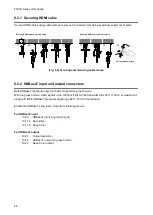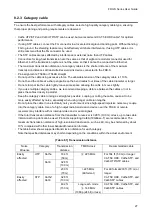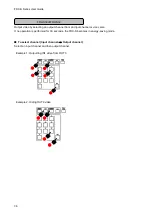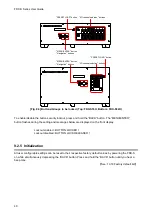
FDX-S Series User Guide
30
8.3.1 RS-232C communication
■
Connecting RS-232C cable
The FDX-
S’s RS-232C connection is supported by a 3-pin captive screw connector.
Insert and secure the wires from the RS-232C cable into the supplied 3-pin captive screw connector, and
then insert the captive screw connector into the mating connector on the FDX-S.
28 AWG to 16 AWG conductor gauge is recommended.
The recommended wire strip length is 0.28 in. (7 mm).
Short RTS/CTS and DTR/DSR as needed.
Tx
Rx
GND
Up to 0.28" (7mm)
Control device
Tx
Rx
GND
FDX-S
RxD
TxD
GND
Signal name
(Receive Data)
(Transmit Data)
(Ground)
[Fig. 8.4] Connecting RS-232C cable to 3-pin captive screw connector
8.3.2 LAN communication
The FDX-S includes the function that is equivalent to those of switching hub. It enables connections between
the FDX-
S’s connector and LAN connectors of HDBaseT transmitters and receivers that are connected to
HDBaseT I/O connectors.
Note:
LAN loop problem
The FDX-S includes switching hub function. If the FDX-S communicates with a product having a switching
hub over LAN, the network may be down due to loop problem.
In case the loop problem occurs, set HDBaseT LAN to
“OFF”.
【
See: 10.13.5 HDBaseT Output LAN
【
See: 10.13.6 HDBaseT Input LAN
■
DHCP
The FDX-S does not support automatic acquisition of IP address using DHCP (Dynamic Host Configuration
Protocol). If you use the FDX-S in a network with DHCP, use a static IP address.
















































